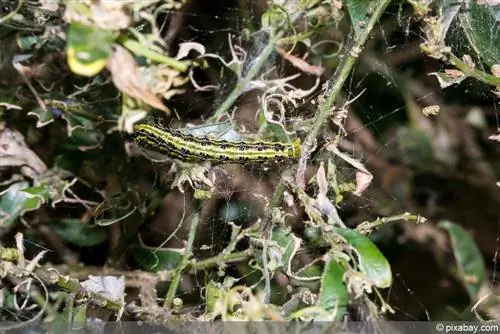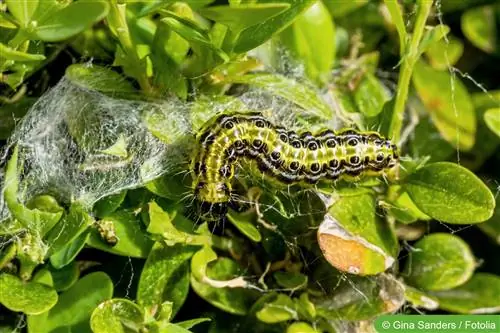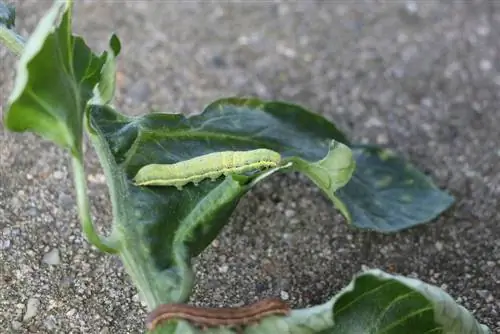- Author admin [email protected].
- Public 2023-12-17 03:39.
- Last modified 2025-01-24 12:45.
If green caterpillars colonize a boxwood, all alarm bells ring for knowledgeable hobby gardeners. They are confronted with the box tree moth, which was introduced from East Asia and which destroyed huge stands of box trees within just a few years. The green caterpillars are the voracious brood that the small butterfly deposits in the bushes. While they go through several larval stages, they mercilessly eat leaves and shoots until the plant dies. In order to combat the voracious pests, various methods have now emerged. The following lines explain the exact procedure.
Lifestyle
Effective control requires precise knowledge of the way of life of a boxwood moth, because it has developed a clever technique that allows the green caterpillars to act in secret for as long as possible. The borer is a small butterfly with cream-colored wings that are bordered in brown. With a wingspan of 4.5 centimeters, it is easy to recognize. During their short lifespan of 10 days, the female butterflies cleverly never stay on a box tree for a long time, but only fly to it to lay their eggs inside the bush. The first generation of caterpillars hatches in March. When fully grown, these are 5 centimeters long and have a green body with black stripes. This is how the infestation progresses:
- The caterpillars eat the leaves and shoots in the lower bush region
- Gradually the pests work their way outward
- They form bright webs to protect against the cold
- Up to 4 generations develop over the course of the year
- The last generation hibernates in the gray cocoons
In the end, the infected boxwood is eaten bare except for the skeleton and is covered in gray or light beige webs that are reminiscent of spider webs. Brown or green droppings can be seen under the boxwood, as a further indication of the presence of the caterpillars.
Tip:
When buying a boxwood, look carefully for the grayish cocoons so as not to purchase a contaminated plant.
Mechanical combat
If the infestation is in an early stage, good success can be achieved through the use of mechanical control techniques. This requires that you regularly examine your boxwood trees for signs such as gray spots, eaten leaves or droppings.
Collect
Environmentally conscious hobby gardeners use this natural method to combat green caterpillars in boxwood. Armed with tweezers, you can locate the normally nimble escapees, especially in the early morning hours when they remain frozen in the bush.
High-pressure cleaner
Once several generations of green-colored larvae have already developed, you can hardly keep up with collecting them. In this case, the sharp jet of water from the high-pressure cleaner removes the pest. Here's how to do it:
- Spread a foil under the boxwood that reaches up to the root neck
- Spray the bush with the water jet of the high-pressure cleaner at the highest possible level
- Start in the crown and continue downwards
- Focus on the inside of the boxwood
Experienced hobby gardeners play it safe by repeating the process several times throughout the day.
Light trap

The measures to contain and eliminate the plague are intensified through the use of light traps. Since the adult butterflies are nocturnal, they are attracted with ultraviolet light and captured by adhesive panels. In this way, you can at least partially prevent further egg laying within a radius of 10 to 15 meters. In addition, this method provides information about the extent of the infestation based on the number of specimens captured.
Biological methods
In order to successfully combat green caterpillars in boxwood, it is not absolutely necessary to use chemical preparations. If the mechanical techniques do not work due to a high number of pests, the next step is to use biological control methods. These score points with the advantage of a procedure that is gentle on beneficial insects. The following alternatives have proven themselves:
Bacillus thuringiensis
This naturally occurring bacterium has become established in responsible pest control worldwide. Since it specifically targets the green caterpillars, neither plants nor vertebrates or even humans are harmed. How to use the product:
- Applicable from a constant temperature of 15 degrees Celsius and higher
- Apply the liquid with a pressure sprayer
- Spray again after waiting 10 days
The biological preparation acts as a feeding poison so that the caterpillars have to ingest it. As soon as this has happened, the feeding stops immediately. A few days later the butterfly caterpillars died.
Neem oil
The boxwood borer has been causing mischief in its Asian homelands for decades. The gardeners there report good success in fighting the green caterpillars with neem oil preparations. Obtained from the seeds of the Indian neem tree, the oil contains a natural insecticide that has a lethal effect on pests. How to use it:
- To prepare as a spray, add 5 ml of neem oil to 1 liter of water
- 1.5 ml of Rimulgan serves as an emulsifier for the oil-water connection
- Filled into a spray gun or pressure sprayer, distribute the agent into the interior of the bush
If the temperatures fall below 7 degrees Celsius, neither biological nor chemical insecticides have any effect against the box tree borer and the green caterpillars. The pests retreat into impenetrable cocoons to overwinter.
Tip:
Position several yellow panels in the immediate vicinity of your boxwoods. With the help of these sticky traps, you can quickly determine whether the boxwood moth is present in the garden.
Beneficial insects avoid the green caterpillars
As part of precise observations, scientists were able to determine that the garden's beneficial insects avoid the green caterpillars of the box tree moth. What works excellently in other areas of biological pest control is not successful in this case. Birds peck at the larvae, but regurgitate them immediately. It can be assumed that they do not get the plant toxins that the caterpillars absorb from the boxwood leaves. The same applies to hedgehogs, frogs or all other comrades in arms of the hobby gardener in the fight against plant pests.
Probate insecticides
If the boxwood borer continues to spread despite all environmentally friendly efforts, the last resort is to resort to chemical-based insecticides. The ingredients thiacloprid and acetamiprid put a lasting stop to adult butterflies and green caterpillars. The following products are currently approved for use in allotment gardens in Germany:
- Bayer Pest Free Calypso
- Celaflor Pest Free Careo
- Etisso pest-free frunol
- Compo Universal insect-free
It is advantageous to purchase a concentrate rather than a ready-to-use mixture. Applied with a pressure sprayer, the insecticide actually reaches deep into the interior of the boxwood. Add another drop of dish soap to lower the surface tension of the water. In this way, the product adheres better to the smooth boxwood leaves. It may be necessary to repeat the application. These products are declared harmful to he alth and require strict safety precautions when used. Since they have to be applied as sprays at high pressure, respiratory protection is essential in addition to protective clothing.
Conclusion
Knowledgeable hobby gardeners have been keeping their boxwoods under close observation since 2007. Since then, the introduced boxwood moth has been causing havoc in Germany and has since destroyed huge populations. It is not the small butterflies themselves, but the green caterpillars that pose a deadly threat to the beautiful shrubs. Fortunately, various methods have now emerged to effectively combat the pests. In the early infestation stage, simple mechanical techniques help to stop the plague. In the second stage, effective biological agents are available. Only when no environmentally friendly approach leads to success do troubled hobby gardeners turn to chemical insecticides. Successfully combating green caterpillars in boxwood is no longer a hopeless endeavor.






